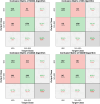Training artificial neural networks using self-organizing migrating algorithm for skin segmentation
- PMID: 39349534
- PMCID: PMC11443081
- DOI: 10.1038/s41598-024-72884-0
Training artificial neural networks using self-organizing migrating algorithm for skin segmentation
Abstract
This study presents an application of the self-organizing migrating algorithm (SOMA) to train artificial neural networks for skin segmentation tasks. We compare the performance of SOMA with popular gradient-based optimization methods such as ADAM and SGDM, as well as with another evolutionary algorithm, differential evolution (DE). Experiments are conducted on the skin dataset, which consists of 245,057 samples with skin and non-skin labels. The results show that the neural network trained by SOMA achieves the highest accuracy (93.18%), outperforming ADAM (84.87%), SGDM (84.79%), and DE (91.32%). The visual evaluation also reveals the SOMA-trained neural network's accurate and reliable segmentation capabilities in most cases. These findings highlight the potential of incorporating evolutionary optimization algorithms like SOMA into the training process of artificial neural networks, significantly improving performance in image segmentation tasks.
Keywords: Artificial neural networks; Computer vision; Optimization algorithm; SOMA; Skin segmentation; Swarm intelligence.
© 2024. The Author(s).
Conflict of interest statement
The authors declare no competing interests.
Figures







References
-
- Chen, H., Geng, L., Zhao, H., Zhao, C. & Liu, A. Image recognition algorithm based on artificial intelligence. Neural Comput. Appl.10.1007/s00521-021-06058-8 (2022). - PubMed
-
- Bilal, A. et al. Bc-qnet: A quantum-infused elm model for breast cancer diagnosis. Comput. Biol. Med.175, 108483. 10.1016/j.compbiomed.2024.108483 (2024). - PubMed
MeSH terms
Grants and funding
LinkOut - more resources
Full Text Sources

